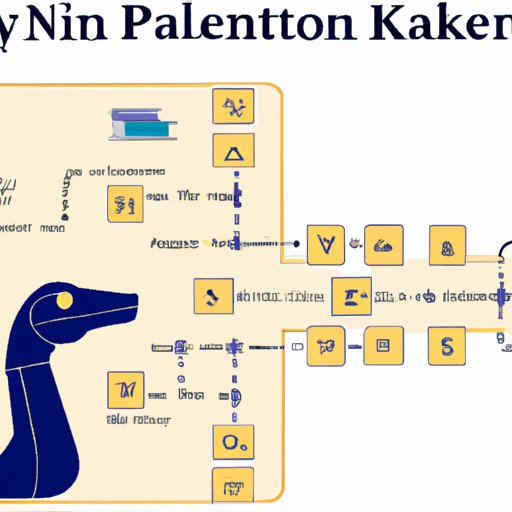Introduction
Data science is an interdisciplinary field that combines mathematics, statistics, computer science, and other techniques to analyze large datasets. It helps to uncover patterns and trends in data, which can be used to make decisions and predictions. As such, data science has become increasingly popular in recent years, with many organizations relying on it to understand their customers and generate insights from their data.
Python is one of the most popular programming languages for data science. It is a high-level language that is easy to learn and use, and it offers a rich set of libraries and tools that make it an ideal choice for data analysis and machine learning. In this article, we’ll explore how Python is used for data science and discuss the advantages it provides.
Exploring the Benefits of Python for Data Science
Python is an excellent choice for data science because it offers a variety of advantages. Here are some of the key benefits:
Speed and Efficiency
Python is fast and efficient, making it well-suited for data analysis tasks. It has a simple syntax, which makes it easy to read and write, and it can handle large datasets quickly and easily. This makes it an ideal choice for data scientists who need to analyze large amounts of data in a short amount of time.
Easy to Learn and Use
Python is a relatively easy language to learn and use. Its syntax is straightforward and intuitive, which makes it simple to pick up even for those with no prior coding experience. This makes it accessible to a wide range of people, including data scientists who may not have a background in coding.
Rich Set of Libraries and Tools
Python also has a rich set of libraries and tools that make it easier to perform data analysis. These include libraries for machine learning, natural language processing, visualization, and more. This makes it easy for data scientists to quickly get started with their projects.

A Guide to Using Python for Data Analysis
Now that you know the benefits of using Python for data science, let’s look at how to actually use it. Here are the steps you need to take to get started:
Setting Up and Installing Python
Before you can start using Python for data science, you’ll need to install it on your computer. You can do this by downloading the latest version of Python from the official website. Once it’s installed, you’ll need to configure it to work with your system.
Utilizing Python Packages
Python comes with a number of packages that you can use for data analysis. These packages offer functions and tools that make it easier to work with data. Some of the most popular packages include Scikit-Learn, TensorFlow, and NumPy.
Understanding Data Structures
In order to effectively analyze data, you’ll need to understand the different data structures available in Python. These include lists, dictionaries, tuples, and sets. Understanding these will help you organize and manipulate data more efficiently.

Understanding the Power of Python in Data Science
Python is a powerful tool for data science. It can be used to create algorithms for machine learning, natural language processing, and visualization. Let’s take a closer look at each of these areas:
Machine Learning
Python is widely used for machine learning. It has a number of powerful libraries and tools, such as Scikit-Learn, that make it easier to build machine learning models. These models can be used to identify patterns in data and make predictions about future events.
Natural Language Processing
Python can also be used for natural language processing (NLP). NLP is used to analyze text and extract meaning from it. With the help of Python, you can build models that can process and understand natural language.
Visualization Techniques
Finally, Python can be used to create visualizations of data. There are a number of libraries, such as Matplotlib and Seaborn, that make it easy to create beautiful visualizations. This makes it easier to understand complex datasets and draw meaningful insights from them.
How Python is Improving Data Science Processes
Python is also being used to improve data science processes. It can be used to automate tasks, streamline workflows, and enhance collaboration between data scientists. Here’s how:
Automation
Python can be used to automate mundane tasks, such as cleaning and preprocessing data. This frees up data scientists to focus on more important tasks, such as building models and analyzing results.
Streamlining Workflows
Python can also be used to streamline workflows. For example, it can be used to create automated pipelines for data analysis, which makes it easier to process large amounts of data quickly and accurately.
Enhancing Collaboration
Finally, Python can be used to enhance collaboration between data scientists. It can be used to create shared libraries and tools, which makes it easier for data scientists to share code and collaborate on projects.

Leveraging Python Libraries for Data Science Projects
Python offers a number of libraries that can be used for data science projects. Here are some of the most popular:
Scikit-Learn
Scikit-Learn is a popular library for machine learning. It offers a variety of algorithms that can be used to build machine learning models, such as linear regression, support vector machines, and decision trees.
TensorFlow
TensorFlow is another popular library for machine learning. It offers a range of tools for building deep learning models, such as neural networks and convolutional neural networks.
NumPy
NumPy is a library for scientific computing. It offers a range of tools for working with numerical data, such as arrays and matrices. It is widely used by data scientists for data analysis and machine learning.
Conclusion
Python is an excellent choice for data science. It offers a number of advantages, such as speed and efficiency, easy to learn and use, and a rich set of libraries and tools. It can be used for a variety of data analysis tasks, such as machine learning, natural language processing, and visualization. It can also be used to automate tasks, streamline workflows, and enhance collaboration between data scientists. Finally, there are a number of popular libraries, such as Scikit-Learn, TensorFlow, and NumPy, that can be used for data science projects.
Overall, Python is a powerful tool for data science, and it offers a number of benefits that make it an ideal choice for data analysis and machine learning.
(Note: Is this article not meeting your expectations? Do you have knowledge or insights to share? Unlock new opportunities and expand your reach by joining our authors team. Click Registration to join us and share your expertise with our readers.)
